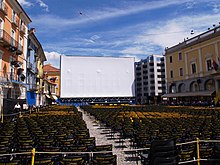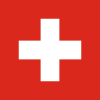| Cinema of Switzerland | |
|---|---|
 Piazza Grande in Locarno during the Locarno Film Festival | |
| No. of screens | 547 (2011)[1] |
| • Per capita | 7.7 per 100,000 (2011)[1] |
| Main distributors | United International Pictures (Schweiz) Gmbh 19.0% Walt Disney Studio (Schweiz) Ag 18.1% Warner Bros. Pictures 15.8%[2] |
| Produced feature films (2011)[3] | |
| Fictional | 31 (36.9%) |
| Animated | 1 (1.2%) |
| Documentary | 52 (61.9%) |
| Number of admissions (2011)[5] | |
| Total | 14,896,020 |
| • Per capita | 2 (2012)[4] |
| National films | 637,554 (4.3%) |
| Gross box office (2011)[5] | |
| Total | CHF 231 million |
| National films | CHF 9.06 million (3.9%) |
| Part of a series on the |
| Culture of Switzerland |
|---|
 |
| People |
| Languages |
| Mythology and folklore |
| Cuisine |
| Festivals |
| Literature |
| Music |
| Sport |
The film industry based in Switzerland dates to the 1930s. It is influenced by the neighboring countries of France, Germany and Italy, with which it shares languages. Before the mid-1960s Swiss films were often sentimental, but the French New Wave led to more experimental cinema.[6]
The Solothurn Film Festival was founded in 1966 with a declaration of showing the modern reality of Swiss Life. It is the most important festival for Swiss film productions.[6]
The Locarno Festival founded in 1946 is an annual film festival held every August in Locarno, Switzerland.
As of 2014, The Swissmakers (1978) (Die Schweizermacher) is the highest grossing Swiss film of all time.[7]
In German-speaking cantons, French-language films usually have German subtitles. Likewise, in French-speaking cantons, German-language films usually have French subtitles. Adult-oriented films in foreign languages are often screened with original audio and double subtitles in German and French. Children-oriented films in foreign languages are usually dubbed.
- ^ a b "Table 8: Cinema Infrastructure - Capacity". UNESCO Institute for Statistics. Archived from the original on 24 December 2018. Retrieved 5 November 2013.
- ^ "Table 6: Share of Top 3 distributors (Excel)". UNESCO Institute for Statistics. Archived from the original on 17 January 2014. Retrieved 5 November 2013.
- ^ "Table 1: Feature Film Production - Genre/Method of Shooting". UNESCO Institute for Statistics. Archived from the original on 5 November 2013. Retrieved 5 November 2013.
- ^ "Country Profiles". Europa Cinemas. Archived from the original on 9 November 2013. Retrieved 9 November 2013.
- ^ a b "Table 11: Exhibition - Admissions & Gross Box Office (GBO)". UNESCO Institute for Statistics. Archived from the original on 24 December 2018. Retrieved 5 November 2013.
- ^ a b "Welcome to the Swiss film industry". The Economist. 31 January 2015.
- ^ Statistik Schweiz - Die erfolgreichsten Schweizer Filme Archived 2012-11-17 at the Wayback Machine. Bfs.admin.ch (2014-04-30). Retrieved on 2014-05-12.